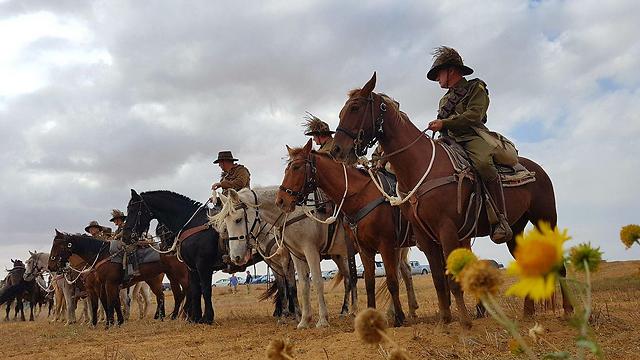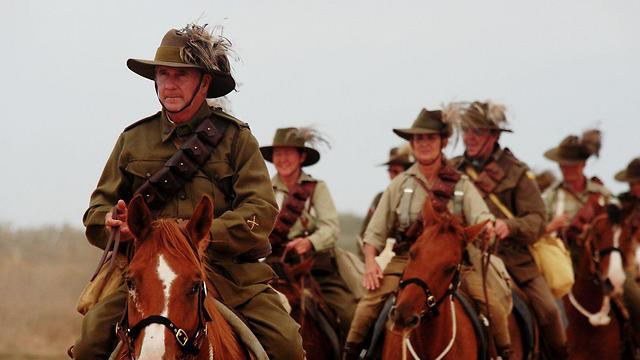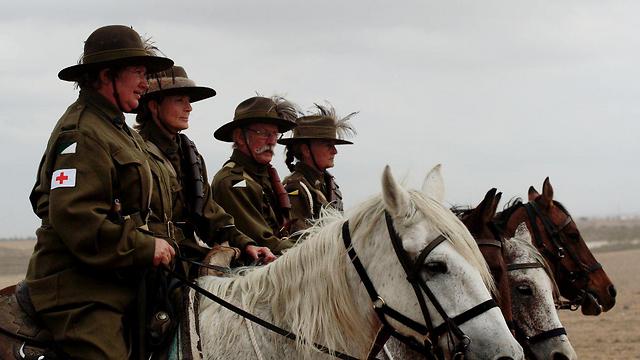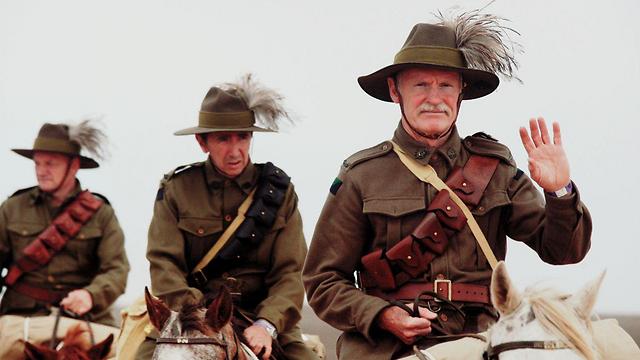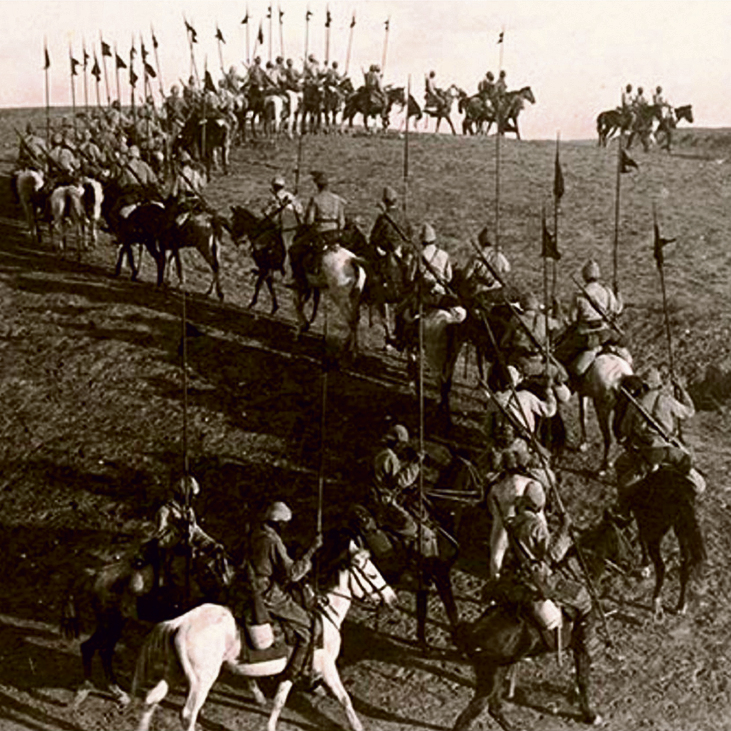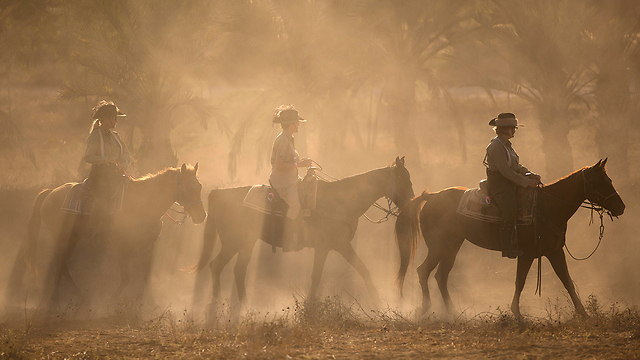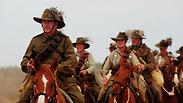

ANZACs ride again: Centennial of the battle of Be'er Sheva
100 Australian, New Zealander cavalrymen participate in recreation of battle of Be'er Sheva fought by mounted ANZAC troops against Ottoman Empire 100 years ago; event to be attended by PM Netanyahu, Australian PM New Zealand governor-general; Tour de France champion Evans to lead charity bike ride tour; mosaic taken by Anzacs recreated by Israeli artists, displayed in Eshkol Regional Council.
While as far as most Israelis are concerned the battle of Be'er Sheva is just another in the myriad battles to take place in the Holy Land, in Australia and New Zealand generations were reared on the myth of the battle now celebrating its centennial, and thus their recent gathering was of particular significance.
The ostentatious celebrations in the southern city are presided over by Prime Minister Benjamin Netanyahu, Australian Prime Minister Malcolm Turnbull—marking his first visit to Israel to participate in the festivities—and New Zealand Governor General Dame Patricia Lee "Patsy" Reddy.
The centennial event was so momentous it was speculated New Zealand Prime Minister Bill English might make a surprise visit as well, considered doubtful due to the tense relationship between the two countries since the 2004 Mossad affair.
Finally, the Ottoman contingent is represented by Turkey's ambassador to Israel, Mekin Mustafa Kemal Ökem.
The event commemorates the freeing of Be'er Sheva by ANZAC (Australian and New Zealand Army Corps) troops, who broke the route to Jerusalem open for British General Edmund Allenby.
The ANZAC troops fought for the British crown in the "Great War" and many lost their lives thousands of miles away from their homeland. The battle is considered historic not only thanks to the important role it played in breaking ground for taking what today is Israel—and the rest of the Middle East—by the British Empire, but also because it was one of the final cavalry battles in modern military history.
Thousands of Australians and Kiwis arrived in Israel to attend the event—which is being broadcast live Australia—some of them related to the brave men who fought in the battle itself and grew up listening to stories about it. Some will even actively participate in its reenactment.
As part of the festivities, the Be'er Sheva municipality is holding ten separate ceremonies all across the city, including the grand opening of the ANZAC soldiers' memorial center, a regal cavalry parade through the Old City's Atzmaut Street, a memorial for New Zealand soldiers in Tel Be'er Sheva, a reenactment of the charge on the city in the Be'er Sheva River Park and more.
Apart from the cavalrymen and their horses, another special guest attended the festival: Australian national hero and former Tour de France champion Cadel Evans, who'll lead a bicycle journey tracing the precise path taken by the cavalrymen 100 years ago.
Proceeds from the ride are dedicated entirely to children afflicted with cancer and persons with disabilities.
The journey, titled "Ride like an ANZAC," will start riders off on a challenging journey taken by the soldiers during the war, starting in the Be'eri kibbutz, passing through HaBesor Stream and culminating in Be'er Sheva itself.
Riders from all over the world are expected to participate in the bike tour, which will take place October 30-31.
"As an Australian native, I also grew up on ANZAC tales of heroism, which is why it's such a great honor for me to invite riders from all over the world to this event saluting and commemorating the brave people who fought on and for Israel," said Danny Hakim, the driving force behind the bike tour and chairman and founder of the Kids Kicking Cancer non-profit, which will receive the proceeds from the tour.
"It's an important part in Israel's historical mosaic, one many Israelis are unfortunately unaware of," he said.
Be'er Sheva Mayor Ruvik Danilovich was excited to greet the guests from down under. "For the first time in the city's history, we have the privilege of commemorating a centennial marking 100 years since the victory in the battle of Be'er Sheva, placing our city on the forefront of cities that played an important role in world heritage," he said.
A mosiac recreated
While Hakim was speaking about a mosaic figuratively, a very real, and very large, mosaic occupied most of artist Yardena Visoker's study in the Eshkol Regional Council's Sde Nitzan moshav.
Along with a group of artists from nearby towns, Visoker painstakingly recreated using tweezers a mosaic first discovered by ANZAC troops during World War I and removed by them as souvenir.
When those soldiers' grandchildren and great-grandchildren returned to Be'er Sheva for the centennial, the recreated mosaic was displayed for them.
The ANZAC cavalrymen rode into Ein Shellal, today Eshkol National Park, in 1917 and set up camp there. The chaplain accompanying the troops, Maitland Woods, walked amongst the springs in the area and gave his blessings to the fighting men before they rode off to battle, when suddenly he noticed part of a spectacular, enormous mosaic floor underfoot, depicting various animals, later found to belong to a Byzantine church built 1,400 years ago and destroyed by Muslims.
The ANZAC troops immediately jumped in and uncovered the entire mosaic in all its splendor. The enthused chaplain decided to take the mosaic back to Australia as a memento and was able to remove the floor—using special tools imported from Egypt—without harming its adornments.
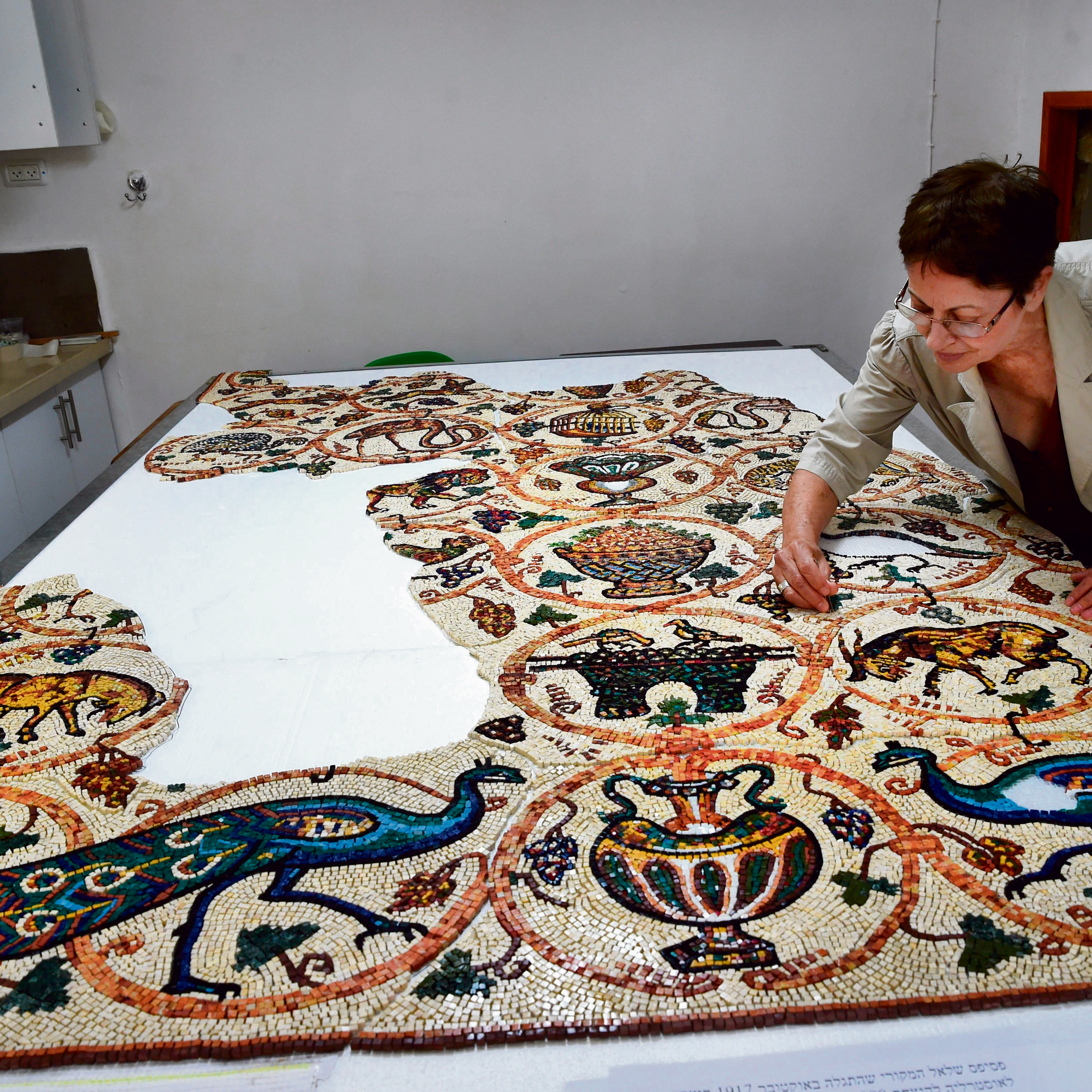
The mosaic pieces were packed away in 53 large crates and placed aboard a ship headed to Australia. "It wasn't quite so easy because after its discovery an argument broke out between the prime ministers of England and Australia over who'll get to keep the mosaic. Eventually the English acquiesced and the mosaic ended up in a museum in Canberra, the capital of Australia," said Visoker, who is also a teacher and lecturer on Israel's history.
In anticipation of the Australians' visit to Israel for the centennial, Visoker contacted the Eshkol Regional Council, which agreed to fund the mosaic's recreation.
Thus, in the past few months 20 artists—presided over by Visoker herself—were hard at work at creating an astonishingly exact replica.
When the reenactment of the battle of Be'er Sheva begins in the Eshkol National Park, it will be right by where their ancestors discovered the original mosaic 100 years ago.
"It's come full circle for me, and it's also a historical wrong now corrected. We'll be presenting the mosaic in our town's cultural hall and to the descendants of the Australian cavalrymen, who were extremely moved by this gesture. It's important to preserve the link between Israel and Australia, and this is yet another step in tightening the years'-long friendship," said Visoker, who's a member of a non-profit for the legacy of the First World War.














